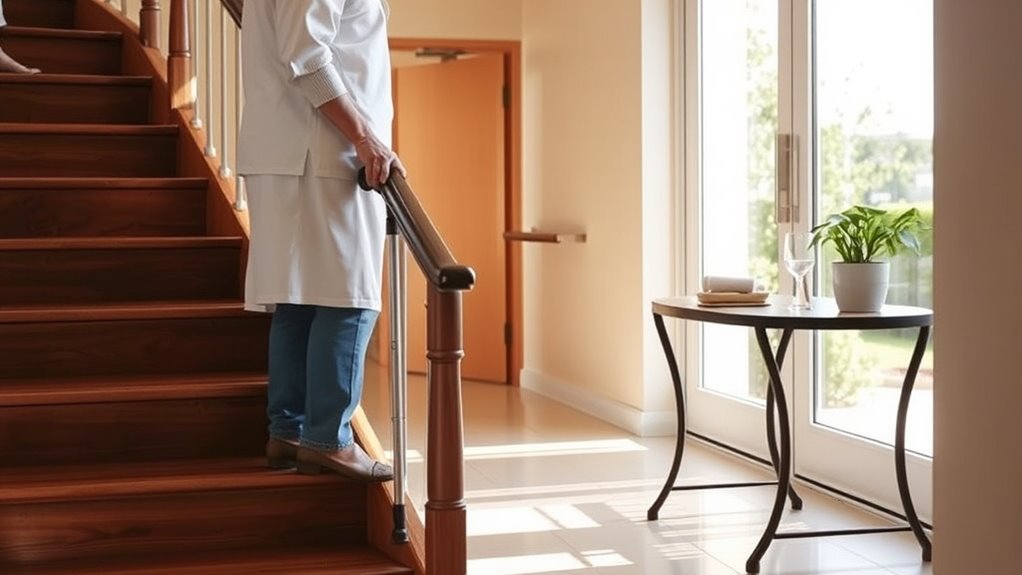To shift from hospital to home care smoothly, start by working with your healthcare team to develop a detailed care plan, including safety precautions and follow-up appointments. Make certain your home environment is safe by removing hazards and installing assistive devices. Manage medications carefully with organized lists and clear instructions. Coordinate transportation and prescriptions, and educate yourself and caregivers on your condition. For a thorough checklist to support your recovery, continue exploring these essential steps.
Key Takeaways
- Develop and review a detailed, written care plan with the healthcare team.
- Arrange for necessary home modifications and safety measures to prevent accidents.
- Confirm follow-up appointments, medication supplies, and transportation before discharge.
- Educate caregivers on managing the patient’s condition and recognizing emergency signs.
- Establish clear communication channels with healthcare providers for ongoing support.

Leaving the hospital and moving back home can feel overwhelming, but careful planning makes the shift smoother. One of your top priorities during this transition is ensuring patient safety. You want to avoid any setbacks or complications, so it’s essential to understand your care needs thoroughly. Make sure you have a clear, written plan provided by your healthcare team that details your medications, appointments, and any special precautions. Patient safety involves being aware of your environment—removing hazards, installing grab bars if needed, and keeping emergency contacts handy. This preparation reduces the risk of falls or accidents and gives you peace of mind as you settle back into your routine. Supporting emotional well-being during this time is also crucial, as adjusting to new routines can be stressful.
Medication management plays a crucial role in your safe recovery. You’ll likely have new prescriptions or adjustments to existing ones, so it’s vital to keep track of your medications accurately. Use a pill organizer or a medication management app to stay on top of your dosing schedule. Always follow your doctor’s instructions precisely, and don’t hesitate to ask questions if anything isn’t clear. If you’re prescribed multiple medications, create a medication list that includes the name, dosage, and timing of each drug. Share this list with your caregiver or family members, so everyone is informed and can assist if needed. Be vigilant about potential side effects and report any adverse reactions to your healthcare provider promptly. Managing medications properly is key to avoiding complications and ensuring your recovery progresses smoothly.
Another important step is arranging for follow-up care before leaving the hospital. Confirm your upcoming appointments and transportation options in advance. Make sure your prescriptions are filled, and all necessary medical supplies or equipment are available at home. If you’re receiving home health services, coordinate with your providers to understand their schedules and your care plan. Having a detailed schedule and clear communication with your healthcare team keeps everyone aligned and prevents gaps in your care. Additionally, understanding emotional support strategies can help you and your loved ones cope better during this transition.
Furthermore, educate yourself and your caregivers about your condition and how to handle common issues that might arise. Knowing what signs indicate a worsening condition or emergency can help you respond quickly. Keep a list of emergency contacts, including your healthcare team, pharmacists, and local emergency services. Make your home environment as safe and comfortable as possible, and establish routines that promote healing. Proper planning, attention to medication management, and prioritizing patient safety will help you transition from hospital to home with confidence and stability. Remember, your recovery is a process, and taking these deliberate steps ensures you’re supported every step of the way.
Frequently Asked Questions
How Do I Handle Medication Side Effects at Home?
You should start by closely monitoring your side effects and keeping a detailed record of any changes or new symptoms. Communicate with your healthcare provider about these observations to adjust your medication management if needed. Don’t ignore mild side effects, but seek immediate help for severe reactions. Staying vigilant and proactive helps guarantee your safety, and your provider can guide you on managing side effects effectively at home.
What Signs Indicate a Need for Urgent Medical Attention?
Like a lighthouse warning of dangerous waters, recognize signs of deterioration such as severe chest pain, difficulty breathing, sudden weakness, or confusion. Emergency symptoms include uncontrolled bleeding, severe pain, or loss of consciousness. If you notice these, don’t hesitate—seek urgent medical attention immediately. Trust your instincts; quick action can prevent further complications and guarantee safety during your passage home.
How Can I Ensure Proper Infection Control at Home?
To guarantee proper infection control at home, you should focus on regular home sanitization by cleaning surfaces with appropriate disinfectants. Always wear personal protective equipment, like masks and gloves, when caring for your loved one or handling contaminated items. Wash hands thoroughly and frequently, especially after touching shared surfaces or medical supplies. Keep the environment clean, ventilated, and organized to minimize the risk of infection spreading.
What Resources Are Available for Caregiver Support?
You can access community support groups and caregiver training programs to help manage your responsibilities. Local nonprofits, healthcare providers, and online resources often offer free or low-cost support tailored for caregivers. These programs provide valuable education, emotional encouragement, and practical tips. Joining these resources helps you stay informed, reduces stress, and guarantees you’re well-equipped to care for your loved one confidently at home.
How Do I Coordinate Follow-Up Appointments Effectively?
Think of follow-up appointments as the compass guiding your loved one’s recovery. To coordinate effectively, keep a detailed calendar for appointment scheduling and medication management. Contact healthcare providers ahead of time to confirm dates and ask about any necessary preparations. Set reminders for each appointment, and make certain transportation is arranged if needed. Staying organized helps you stay on top of care and avoid missed visits, ensuring your loved one stays on the path to healing.
Conclusion
Moving from hospital to home care might seem overwhelming, but with proper planning, you can make it smooth. Remember, about 70% of patients feel more confident when they have clear instructions and support systems in place. Staying organized and communicating with your healthcare team ensures a safer, quicker recovery. Embrace this new chapter with confidence—you’re taking important steps toward healing and independence. You’re capable of managing your care and thriving at home.









